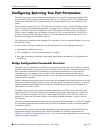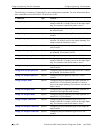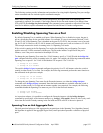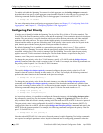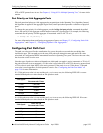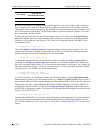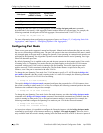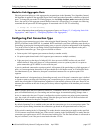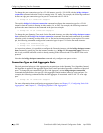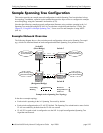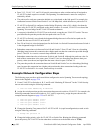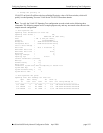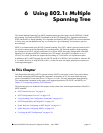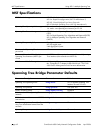
Configuring Spanning Tree Parameters Configuring Spanning Tree Port Parameters
OmniSwitch 6600 Family Network Configuration Guide April 2006 page 5-27
Mode for Link Aggregate Ports
Physical ports that belong to a link aggregate do not participate in the Spanning Tree Algorithm. Instead,
the algorithm is applied to the aggregate logical link (virtual port) that represents a collection of physical
ports. To change the port mode for a link aggregate, use the bridge slot/port mode commands described
above, but specify a link aggregate control number instead of a slot and port. For example, the following
command sets the port mode for link aggregate 10 associated with VLAN 755 to blocking:
-> bridge 755 10 mode blocking
For more information about configuring an aggregate of ports, see Chapter 12, “Configuring Static Link
Aggregation,” and Chapter 13, “Configuring Dynamic Link Aggregation.”
Configuring Port Connection Type
Specifying a port connection type is done when using the Rapid Spanning Tree Algorithm and Protocol
(RSTP), as defined in the IEEE 802.1w standard. RSTP transitions a port from a blocking state directly to
forwarding, bypassing the listening and learning states, to provide a rapid reconfiguration of the Spanning
Tree in the event of a path or root bridge failure. Rapid transition of a port state depends on the port’s
configurable connection type. These types are defined as follows:
• Point-to-point LAN segment (port connects directly to another switch).
• No point-to-point shared media LAN segment (port connects to multiple switches).
• Edge port (port is at the edge of a bridged LAN, does not receive BPDU and has only one MAC
address learned). Edge ports, however, will operationally revert to a point to point or a no point to
point connection type if a BPDU is received on the port.
A port is considered connected to a point-to-point LAN segment if the port belongs to a link aggregate of
ports, or if auto negotiation determines if the port should run in full duplex mode, or if full duplex mode
was administratively set. Otherwise, that port is considered connected to a no point-to-point LAN
segment.
Rapid transition of a designated port to forwarding can only occur if the port’s connection type is defined
as a point to point or an edge port. Defining a port’s connection type as a point to point or as an edge port
makes the port eligible for rapid transition, regardless of what actually connects to the port. However, an
alternate port transition to the role of root port is always allowed regardless of the alternate port’s connec-
tion type.
Note. Configure ports that will connect to a host (PC, workstation, server, etc.) as edge ports so that these
ports will transition directly to a forwarding state and not trigger an unwanted topology change when a
device is connected to the port. If a port is configured as a point to point or no point to point connection
type, the switch will assume a topology change when this port goes active and will flush and relearn all
learned MAC addresses for the port’s assigned VLAN.
By default, Spanning Tree is enabled on the port and the connection type is set to auto point to point. The
auto point to point setting determines the connection type based on the operational status of the port.
If the switch is running in the 1x1 Spanning Tree mode, then the connection type applies to the specified
VLAN instance associated with the port. If the switch is running in the flat Spanning Tree mode, then the
connection type applies across all VLANs associated with the port. The flat mode instance is referenced as
the port’s instance, even if the port is associated with other VLANs.



